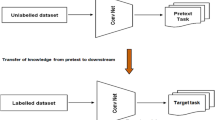Abstract
Sample generation is an effective way to solve the problem of the insufficiency of training data for hyperspectral image classification. The generative adversarial network (GAN) is one of the popular deep learning methods, which utilizes adversarial training to generate the region of samples based on the required class label. In this paper, we propose cascade conditional generative adversarial nets for hyperspectral image complete spatial-spectral sample generation, named C2GAN. The C2GAN includes two stages. The stage-one model consists of the spatial information generation with a window size that entails feeding random noise and the required class label. The second stage is the spatial-spectral information generation that generates spectral information of all bands in the spatial region by feeding the label regions. The visualization and verification of generated samples based on the Pavia University and Salinas datasets show superior performance, which demonstrates that our method is useful for hyperspectral image classification.
Similar content being viewed by others
References
Ghamisi P, Maggiori E, Li S T, et al. New frontiers in spatial-spectral hyperspectral image classification: the latest advances based on mathematical morphology, Markov random fields, segmentation, sparse representation, and deep learning. IEEE Geosci Remote Sens Mag, 2018, 6: 10–43
Li S T, Song W W, Fang L Y, et al. Deep learning for hyperspectral image classification: an overview. IEEE Trans Geosci Remote Sens, 2019, 57: 6690–6709
Chen Y S, Jiang H L, Li C Y, et al. Deep feature extraction and classification of hyperspectral images based on convolutional neural networks. IEEE Trans Geosci Remote Sens, 2016, 54: 6232–6251
Xu X D, Li W, Ran Q, et al. Multisource remote sensing data classification based on convolutional neural network. IEEE Trans Geosci Remote Sens, 2018, 56: 937–949
Goodfellow I J, Pouget-Abadie J, Mirza M, et al. Generative adversarial nets. In: Proceedings of the 27th International Conference on Neural Information Processing Systems, 2014. 2672–2680
Mirza M, Osindero S. Conditional generative adversarial nets. 2014. ArXiv: 1411.1784
Zhu L, Chen Y S, Ghamisi P, et al. Generative adversarial networks for hyperspectral image classification. IEEE Trans Geosci Remote Sens, 2018, 56: 5046–5063
Zhan Y, Hu D, Wang Y T, et al. Semisupervised hyperspectral image classification based on generative adversarial networks. IEEE Geosci Remote Sens Lett, 2018, 15: 212–216
Feng J, Yu H P, Wang L, et al. Classification of hyperspectral images based on multiclass spatial-spectral generative adversarial networks. IEEE Trans Geosci Remote Sens, 2019, 57: 5329–5343
Xu Y H, Du B, Zhang L. Can we generate good samples for hyperspectral classification?—A generative adversarial network based method. In: Proceedings of IEEE International Geoscience and Remote Sensing Symposium, 2018. 5752–5755
Wang X, Tan K, Du Q, et al. Caps-TripleGAN: GAN-assisted CapsNet for hyperspectral image classification. IEEE Trans Geosci Remote Sens, 2019, 57: 7232–7245
Lei N, Guo Y, An D, et al. Mode collapse and regularity of optimal transportation Maps. 2019. ArXiv: 1902.02934
Arjovsky M, Chintala S, Bottou L. Wasserstein gan. 2017. ArXiv: 1701.07875
Miyato T, Kataoka T, Koyama M, et al. Spectral normalization for generative adversarial networks. 2018. ArXiv: 1802.05957
Yinka-Banjo C, Ugot O A. A review of generative adversarial networks and its application in cybersecurity. Artif Intell Rev, 2019. doi: https://doi.org/10.1007/s10462-019-09717-4
Krizhevsky A, Sutskever I, Hinton G E. ImageNet classification with deep convolutional neural networks. Commun ACM, 2017, 60: 84–90
Isola P, Zhu J Y, Zhou T, et al. Image-to-image translation with conditional adversarial networks. In: Proceedings of the IEEE Conference on Computer Vision and Pattern Recognition, 2017. 1125–1134
Kruse F A, Lefkoff A B, Boardman J W, et al. The spectral image processing system (SIPS)-interactive visualization and analysis of imaging spectrometer data. In: Proceedings of AIP Conference Proceedings, 1993. 192–201
He K M, Zhang X Y, Ren S Q, et al. Deep residual learning for image recognition. In: Proceedings of 2016 IEEE Conference on Computer Vision and Pattern Recognition (CVPR), 2016. 770–778
Acknowledgements
This work was supported by National Nature Science Foundation of China (Grant Nos. 61973285, 61873249, 61773355, 61603355), National Nature Science Foundation of Hubei Province (Grant No. 2018CFB528), Opening Fund of the Ministry of Education Key Laboratory of Geological Survey and Evaluation (Grant No. CUG2019ZR10), and Fundamental Research Funds for the Central Universities (Grant No. CUGL17022).
Author information
Authors and Affiliations
Corresponding author
Rights and permissions
About this article
Cite this article
Liu, X., Qiao, Y., Xiong, Y. et al. Cascade conditional generative adversarial nets for spatial-spectral hyperspectral sample generation. Sci. China Inf. Sci. 63, 140306 (2020). https://doi.org/10.1007/s11432-019-2798-9
Received:
Revised:
Accepted:
Published:
DOI: https://doi.org/10.1007/s11432-019-2798-9




